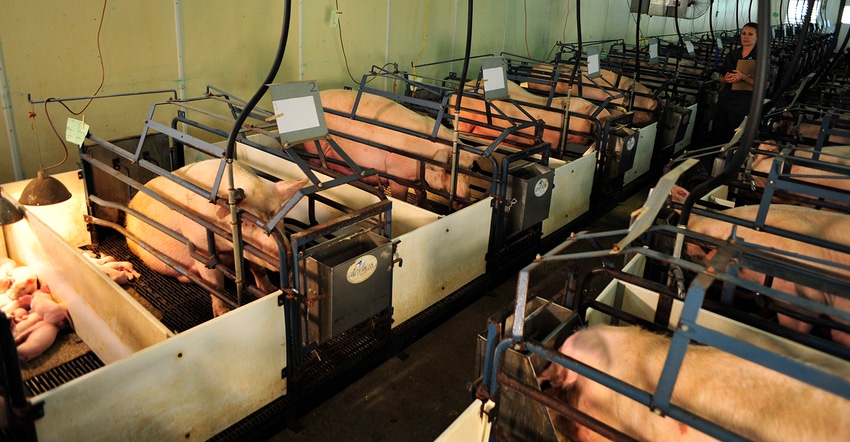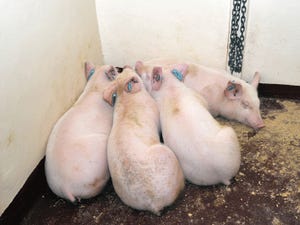Pelvic organ prolapse: On-farm considerations
In the survey, a greater percentage of thinner sows prolapsed compared to normal condition or overweight sows.
February 2, 2022

In response to increasing sow mortality due to pelvic organ prolapse, the Iowa Pork Industry Center at Iowa State University, with funding from the National Pork Board, assembled a research team to better understand potential causative factors of sow POP in order to move towards developing and disseminating prevention strategies to help reduce POP incidence.
One hundred and four commercial sow farms across the United States (85 farms from 13 larger production systems and 19 farms representing independent producers) with varying POP incidence, geographical locations, genetics and management practices were enrolled in this project. Within production systems, enrollment from farms with relatively high incidence, average incidence and relatively low incidence of POP was utilized. During the course of the survey, on-farm visits were conducted and individual animal measurements were acquired from 62 sow farms to determine any association with POP.
This study was designed to provide research direction for future projects investigating causative factors of POP and cultivate a collaborative network throughout the industry. Additionally, our analysis did identify a few factors that could be monitored on a day-to-day basis while working toward POP mitigation and improved management of sows:
Keep an eye on sow body condition score during late gestation. In the survey, a greater percentage of thinner sows prolapsed compared to normal condition or overweight sows. This suggests that close monitoring of sow body condition throughout gestation is important to ensure that ideal body condition is being achieved and maintained.
Consider bump feeding sows that have a low body condition score. Farms enrolled in the survey that used a bump feeding strategy (i.e. increasing feed intake) during late gestation targeting sows with a low BCS had lower (P = 0.03) POP rates compared to farms not using a bump feeding strategy. The same trend was not observed for total mortality, suggesting energy intake and/or body condition prior to farrowing may have some effect on risk of POP-induced mortality.
Managing feed intake prior to farrowing. When categorizing farms by feed allotment in farrowing crates prior to farrowing (fed less than 5 pounds/day compared to those farms feeding 5 or more pounds/day), the farms feeding less than 5 pounds had a greater POP incidence (P < 0.01). However, it should be noted that the number of days prior to farrowing that sows were loaded into crates was not accounted for.
Gilt size at breeding. While multiple components collectively determine when a gilt should receive her first service, the size of the gilt at breeding may be worth considering. In our observations POP incidence was somewhat correlated with gilt size at the time of breeding (R2 = 0.11, P = 0.03), with farms that had lighter gilts at the time of breeding (measured by flank-to-flank girth) also having a higher POP incidence.
Perineal scoring. Perineal scoring is an assessment tool developed by our team that enables the ability to categorize risk of POP in sows when conducted during late gestation (approximately days 107-116). In assignment of perineal scores, a perineal score of 1 (PS1) presumes little to no risk of prolapse, and has none of the following: protrusion, vulva swelling and swelling of the perineal region. By comparison, a perineal score of 3 (PS3) presumes high risk of prolapse, and has all of the following: protrusion, vulva swelling and swelling of the perineal region. Additional information on perineal scoring can be found here.
During multiple studies, we have demonstrated that sows assigned a PS3 have a greater risk of POP than sows with assigned PS1 or PS2. Additional work by our team has demonstrated that sows with a PS3 have altered immune cell profiles and steroid hormone abundances compared to sows with a low risk (PS1) for POP.
While an industry survey of this nature does not identify specific causative factors for POP, the above items represent some important aspects of managing sow health that could be related to POP risk. Current research is ongoing to further understand the biological causes of POP. Our group has continued to pursue a biological understanding of POP risk and its association with alterations in the vaginal microbiota and markers of inflammation, while also exploring strategies for POP mitigation.
Additional information (reports, fact sheets and short videos) on these topics, and many others, can be found on our project website.
Source: Jason W. Ross, Zoe E. Kiefer and Jamie M. Studer, who is solely responsible for the information provided, and wholly owns the information. Informa Business Media and all its subsidiaries are not responsible for any of the content contained in this information asset. The opinions of this writer are not necessarily those of Farm Progress/Informa.
You May Also Like



